Netflix seems poised to implement some of the biggest changes to its business model in years. In the company’s Q1 2022 earnings call, CEO Reed Hastings dropped two bombshells.
Netflix lost subscribers
First: Netflix lost subscribers for the first time in a decade — 200,000 to be specific. That’s a far cry from the 2,000,000 subscribers the company predicted it would gain just three months ago.
It’s worth noting that Netflix is in the red on its subscriber count in part because of Russia’s invasion of Ukraine — it lost 700,000 accounts after shutting down its services in Russia. Still, even ignoring that chunk of accounts, Netflix fell well behind expectations.
In order to continue to combat dwindling growth, Netflix plans to crack down on password sharing, something which Hastings has previously called “a positive thing” on multiple occasions.
On today’s call, Hastings instead said “we’ve just got to get paid for them,” referring to the estimated 100 million viewers who use the service for free. Netflix says that its anti-password sharing system will take a year or so to deploy globally.
The crackdown on password sharing doesn’t come as a huge surprise. I’d imagine most Netflix users knew this was coming eventually, but Netflix was still growing quickly enough that the company didn’t consider password sharing to be a major issue.
The company has actually been testing deterrents to password sharing for a few months now. That said, COO Greg Peters indicated that Netflix may not completely eliminate password sharing but rather charge people for it. That suggests the company might consider offering a shared plan for people that might not live in the same household, although Peters didn’t specify as much.


Although the company placed a lot of the blame on password sharing, that’s not something new nor does it appear to have increased dramatically recently. The company’s growth has stalled in large part because there’s only so much screentime to go around and the company keeps on raising prices. Competitors — which are often cheaper — have good shows too.
Ads are (probably) coming
More surprising was the second bombshell: it seems all but certain Netflix will introduce an ad-supported tier down the road.
Hastings said the company is now “quite open” to ad-supported subscriptions after years of being against them:
“Those who have followed Netflix have known that I’m against the complexity of advertising and I’m a big fan of the simplicity of subscriptions. But as much as I’m a fan of that, I’m a bigger fan of consumer choice, and allowing consumers who would like to have a lower price and are advertising tolerant get what they want makes a lot of sense.”
While offering an ad-supported tier is common for streaming services, it’s a dramatic shift for a company that has made its lack of ads part of its identity. In 2019, Hastings blatantly denied any rumors of Netflix moving to an ad-supported model.
But I’m fine with them
While some will miss the sanctity of ad-free Netflix, I think it’s ultimately a good thing. Netflix has raised prices six times in the last eight years, making subscriptions twice as expensive as they were in 2014. While the company would ideally, you know, stop charging people more money, that’s probably not going to happen. Offering those who only want to watch Netflix occasionally a more affordable option strikes me as a good thing.
I assume the ad-supported tier will be Netflix’s cheapest plan, but frankly, I wouldn’t mind if the company offered an ad-supported option at higher resolutions as well. I’m not a huge binge-watcher, so I don’t mind an ad here and there if it means I get to save a few bucks. But I am picky about image quality, so I still want to watch my favorite shows in glorious 4K. If Hastings really wants to give consumers more options, I hope the ad-supported tier isn’t limited to potato-quality 480p.
